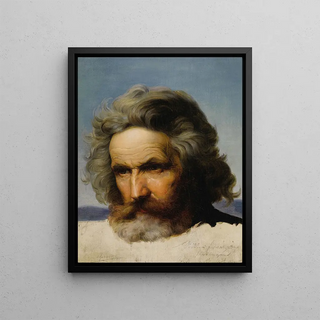Art print | Study of a bearded man - Karl Friedrich Lessing


View from behind

Frame (optional)
Reproduction of "Study of a Bearded Man" by Karl Friedrich Lessing – Captivating Introduction
The artwork "Study of a Bearded Man" by Karl Friedrich Lessing emerges as a poignant testament to the artistic sensitivity of the 19th century. In a context where painting strives to capture not only the face but also the human soul, this study stands out for its psychological depth and realistic approach. The artist, by focusing on the male figure, invites us to explore the nuances of human expression, while revealing the subtleties of light and shadow that sculpt the face of his model. It is a piece that does not merely depict a man but endeavors to grasp the very essence of his being, creating an intimate connection between the viewer and the subject.
Style and uniqueness of the work
Lessing's style in this piece is characterized by striking realism, where every detail is meticulously observed and reproduced. The texture of the beard, the depth of the eyes, and even the wrinkles that betray life's experience are rendered with remarkable precision. Choosing to depict a bearded man is no coincidence; it symbolizes wisdom and quiet strength—qualities often associated with masculinity. The color palette, subtle and nuanced, helps create a contemplative atmosphere that invites reflection. Each brushstroke seems to breathe life, and the overall composition exudes harmony that irresistibly draws the eye. The work thus reveals itself as a window into the soul, where the viewer is invited to ponder the stories and thoughts hidden behind this face.
The artist and his influence
Karl Friedrich Lessing, painter and illustrator, is often regarded as an emblematic figure of German Romanticism. His work, although sometimes overshadowed by that of his contemporaries, demonstrates great technical mastery and sensitivity to the psychology of characters. Lessing navigated between tradition and innovation, integrating elements of classical painting while exploring more contemporary themes. His influence is evident in the artistic movement that followed, inspiring many artists to explore the representation of the individual in all its complexity.

Matte finish

View from behind

Frame (optional)
Reproduction of "Study of a Bearded Man" by Karl Friedrich Lessing – Captivating Introduction
The artwork "Study of a Bearded Man" by Karl Friedrich Lessing emerges as a poignant testament to the artistic sensitivity of the 19th century. In a context where painting strives to capture not only the face but also the human soul, this study stands out for its psychological depth and realistic approach. The artist, by focusing on the male figure, invites us to explore the nuances of human expression, while revealing the subtleties of light and shadow that sculpt the face of his model. It is a piece that does not merely depict a man but endeavors to grasp the very essence of his being, creating an intimate connection between the viewer and the subject.
Style and uniqueness of the work
Lessing's style in this piece is characterized by striking realism, where every detail is meticulously observed and reproduced. The texture of the beard, the depth of the eyes, and even the wrinkles that betray life's experience are rendered with remarkable precision. Choosing to depict a bearded man is no coincidence; it symbolizes wisdom and quiet strength—qualities often associated with masculinity. The color palette, subtle and nuanced, helps create a contemplative atmosphere that invites reflection. Each brushstroke seems to breathe life, and the overall composition exudes harmony that irresistibly draws the eye. The work thus reveals itself as a window into the soul, where the viewer is invited to ponder the stories and thoughts hidden behind this face.
The artist and his influence
Karl Friedrich Lessing, painter and illustrator, is often regarded as an emblematic figure of German Romanticism. His work, although sometimes overshadowed by that of his contemporaries, demonstrates great technical mastery and sensitivity to the psychology of characters. Lessing navigated between tradition and innovation, integrating elements of classical painting while exploring more contemporary themes. His influence is evident in the artistic movement that followed, inspiring many artists to explore the representation of the individual in all its complexity.






